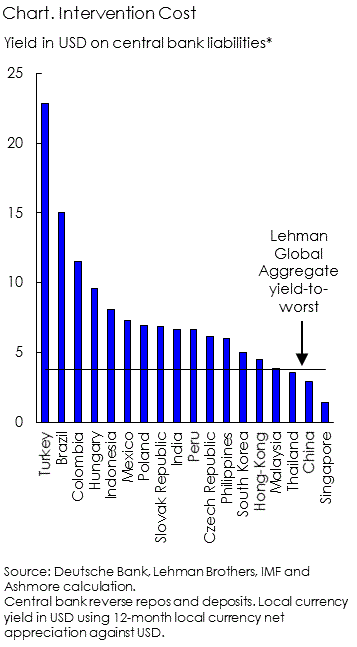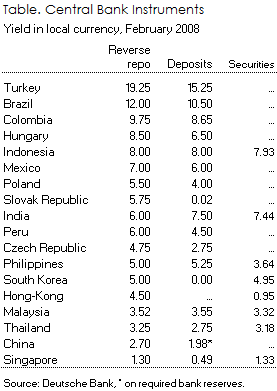Foreign reserves carry costs
5 March 2008
Ousmène Jacques Mandeng, Ashmore Investment Management
Holding international reserves can be quite costly. The financial implication of holding reserves of course only represents one aspect of reserve holding and many central banks would argue that the benefits far outweigh the costs. However, reserves affect central banks’ profit and loss account and as such do have an immediate incidence on the financial soundness of central banks and as such on the effectiveness of central banks. Large losses from holding reserves may require central banks to seek recapitalization from the government and ultimately may represent a fiscal cost. At the extreme, this may impair central bank independence.
Most central banks have to sterilize at least some of their foreign currency reserves and/or fund by issuing interest bearing instruments. At the margin, the cost of holding reserves can be measured by the difference between the yield on reserve assets and yield on central bank liabilities including reverse repurchase operations, deposit and securities issued by the central bank. The yield on reserves is often assumed mostly a constant, determined by average government-related securities’ yields. As an indication of this, the Lehman Global Aggregate index had a yield-to-worst of 3.8 percent at end-February. The marginal carry cost therefore depends largely on marginal interest rates of central bank liabilities.
The carry cost is a linear function of domestic interest rates and exchange rate fluctuations. Countries with high domestic interest rate and an appreciating exchange rate exhibit naturally the highest carry cost. Data from selected central banks harmonized in dollar-terms show that for many central banks, marginal carry costs are negative (Chart). Costs differ also by the instrument used (Table). As central banks’ liabilities normally include a large proportion of non-interest bearing instruments, the marginal carry cost may not be indicative of total central bank interest expenses. Yet, it is still the benchmark for efficient balance sheet management.
The financial cost of holding reserves has come increasingly to the fore as reserves had been accumulating rapidly. With reserves now on average representing 19 percent of GDP, losses incurred on holding reserves can potentially be substantial. Central banks may therefore have to choose between reducing reserves or seeking a higher return on their investments. Many major emerging markets central banks are currently reviewing their investment strategies. Fiscal considerations may yet again be the key to effective central banking.

